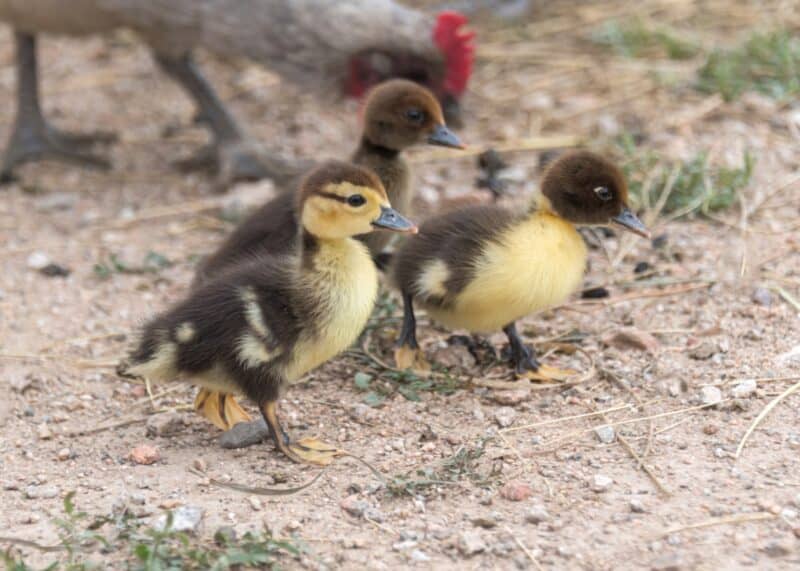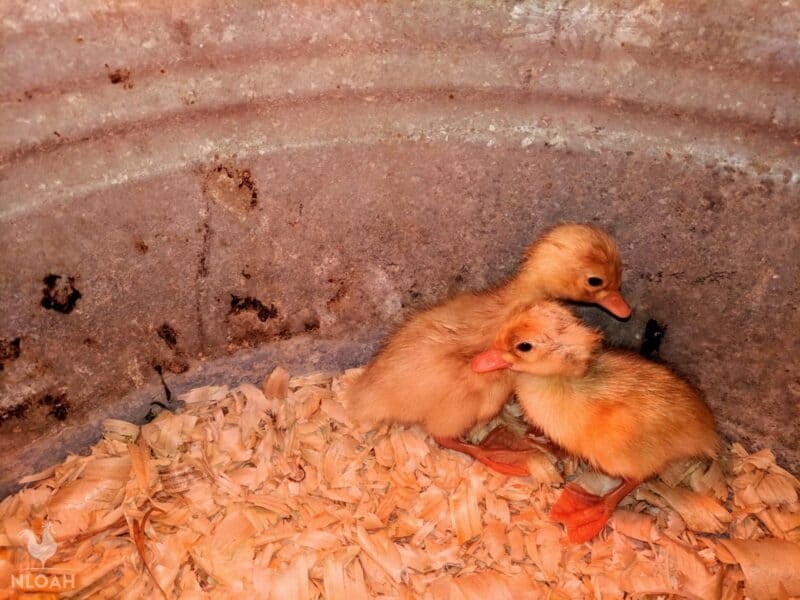The most precious, adorable time in a duck’s life is when it is still a fuzzy little baby duckling. I’m telling you, there’s nothing on Earth cuter!

But, they really do grow up fast and as much as we might want them to stay small and fuzzy forever, getting their feathers is an important milestone in their life. This is when we know our ducks are truly ready to go outside and join the flock.
Accordingly, we need to know when those feathers will come in so we can plan around it. So, when should you expect your ducklings to get their feathers?
Your ducklings will have a full set of adolescent feathers at around 6 to 8 weeks, and their adult feathers will grow in later after the first molt, around 10 to 12 weeks.
It’s as simple as that. There are some variations in that timetable to consider based on breed and a few other factors we will talk about, but ducklings really do grow remarkably quickly.
Enjoy that short time of fuzzy cuteness, because it won’t last! There’s a lot more you’ll want to know concerning the feathering of your ducklings, so keep reading and we will get into it.
Are Ducklings Born with Feathers?
Yes, in a manner of speaking. Ducklings are born with soft, thin hair-like feathers called down. They really aren’t much to look at as soon as they come out of the shell, because they’re wet, scraggly, and barely able to move, but they will dry out pretty quickly.
In no more than half a day, maybe a full day at the very longest, those down feathers will dry and straighten out and you can bask in the cuteness of a perfectly fuzzy duckling.
How Long Do Ducklings Have Their Down?
Not very long, sadly! I know I’m going on about them at this point, but it really is my favorite time in their lives. Ducklings only stay downy for about 10 days, 12 at the absolute most.
That’s because they will quickly grow in their next set of proper feathers that will change their appearance dramatically. As these feathers come in as they get bigger and bigger, they will look more and more like adults.
When Do Proper Feathers Start to Come In?
Very quickly! Within the second week, the primary flight feathers start to appear. Within the third week, the secondary flight feathers will emerge. There’s still a long way to go, but you can expect your ducklings to have their full set of adolescent or “teenage” feathers anywhere from week 6 to week 8!
At this point, they will look very much like a fully grown adult duck, but do note that these teenage feathers are duller and often lack some of the patterning that adult feathers have. Additionally, many duck breeds won’t quite be fully grown by this time.
How Long Does It Take for Adult Feathers to Fully Develop?
Around 10 to 12 weeks. At this time, most ducks are physically mature and will molt, getting rid of their juvenile plumage for their distinct and recognizable adult feathers.
At this point, they are truly ready to join the flock and stay outside at all times – though most ducklings can go outside for long stretches with no issues before this point as long as the weather is temperate!
When Can Ducklings Fly?
Your ducklings will be able to fly, assuming they can fly, when they have a full set of juvenile feathers. The good news is that most domestic ducks cannot fly, or if they can, it is only for relatively short hops.
However, if you have wild ducks or any breeds that are known to be flighty, you’ll have to clip their wings, contain them, or put wing weights on them to keep them from heading for greener pastures.
Some Muscovies, Calls, Mallards, and Black East Indies are known to be flyers, so pay attention around this time!
Do Some Duck Breeds Get Their Feathers Sooner or Later?
Yes, of course. As a rule, your slower-growing breeds will likewise develop their feathers slower. Breeds that grow and mature more quickly get them faster.
Count on Calls feathering quite quickly, with many losing noticeable amounts of down at the end of the first week. Slow-growing heritage breeds like Rouens might not be finished molting even by week 12, with the so-called “fancy” or “ornamental” strains being especially slow to grow and feather.
If you have a mixed batch of ducklings, this is important to know because they won’t all be ready to go outside together – even if they hatch at the same time!

What Influences Feather Growth Rates?
All of the timelines I provided above are simply baselines, assuming that everything goes right when it comes to brooding and your ducklings are healthy.
Sometimes, things don’t go according to plan and ducklings might feather at a later date, or feather noticeably slowly compared to their siblings. The following factors can impact feathering timetables:
Genetics
Ducks have their own lineages just like people do, and some are healthier than others or just quirkier.
For any given breed, it’s possible your ducklings might feather a little earlier or a little later, or their feathers might come in faster or slower once feathering has begun. It’s the same thing with molting.
Environment
Environment is everything when it comes to the health and development of your ducklings. If they are too hot, too cold, scared, crowded, or in any way subjected to suboptimal conditions, they will tend to grow slower and feather later.
Major stress during feathering is a common cause of illness and subsequent death because it is such a resource-intensive time in their young lives.
Illness
Ducks, and that includes ducklings, are remarkably healthy but they can still get sick. Ducklings that get sick during the first two weeks of life are far more prone to dying or suffering from subsequent developmental problems. Illness that strikes prior to feathering might severely delay or, in some cases, even prevent it.
Aspergillosis, a respiratory tract infection caused by mold spores, is common and deadly. It is often caused by unsanitary or damp conditions in the brooder. Wet feather is likewise caused by filthy, wet living conditions.
Coccidiosis is a parasitic infection of the intestines that can prevent your babies from absorbing nutrition that they desperately need. It is treatable with meds.
Duck virus hepatitis is another shockingly lethal illness that affects ducklings; sadly, it has a nearly 100% mortality rate and kills in hours. You’ll see some spasming and arcing of the back prior to death, but it usually strikes quickly and can wipe out your brood.
Make sure you practice good biosecurity with your little ones and keep their brooder environment clean to keep disease at bay.
Nutrition
Ducklings are huge eaters because they tend to double in weight every single week. Likewise, growing feathers has a huge nutritional demand in terms of calories, protein, and other nutrients.
Your baby ducklings must have proper nutrition at all phases of life if you want their feathers to come in properly.
A specialized starter feed for ducklings or waterfowl is the very best choice, as it will be nutritionally optimized for their protein, calorie and micronutrient needs. Ducklings can also have small amounts of leafy vegetables, fruit, seeds and just a few grains as snacks to round out their diet.
Hormones
Don’t forget at the end of the day that hormones play a huge and vital role in the growth of feathers and subsequent molting.
Coricosterone is a “stress” hormone that is absorbed into the feathers during molting, but the sex hormones (testosterone, estrogen) and others also affect feathering at all phases of growth.
If, for whatever reason, your birds are suffering from reduced hormone production, it’s possible that feathering will slow or fail to occur in some cases. It can be difficult to spot, too, as it is often mistaken for other illnesses or issues.
Hormone production shortfalls could be genetic as mentioned above, due to a nutritional imbalance, or other problems.
Exposure to toxins and contaminants is a likely cause of hormonal disruption in ducklings, too. It is possible to give ducklings treatment for hormonal imbalances, but you’ll need to check with your vet.
Tom has lived and worked on farms and homesteads from the Carolinas to Kentucky and beyond. He is passionate about helping people prepare for tough times by embracing lifestyles of self-sufficiency.
